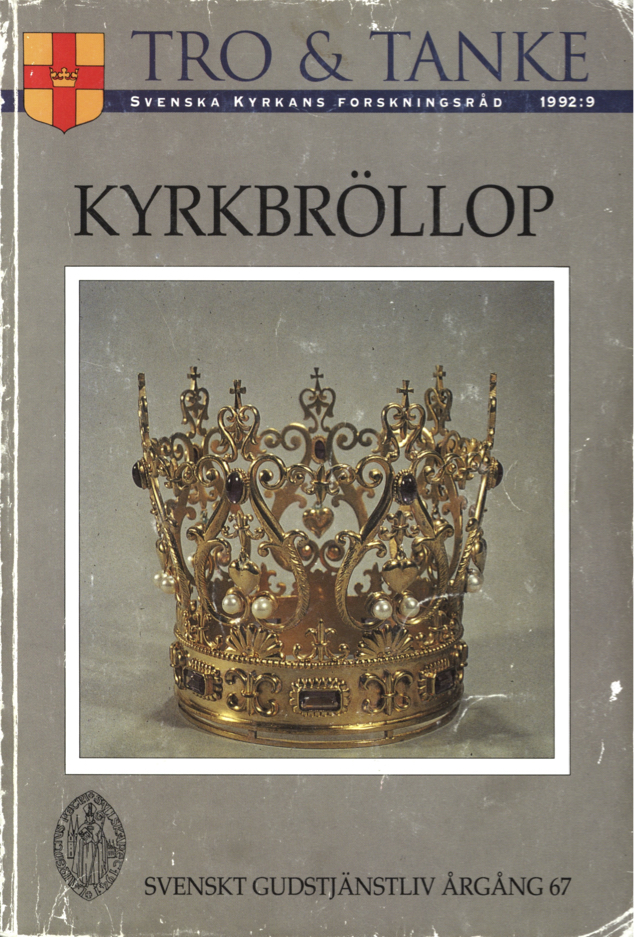Vigselgudstjänstens teologi och liturgi
Abstract
A new ritual for the marriage service is in use in the Swedish church since 1986. It is here being discussed from a theological and liturgical perspective, and in the light of historical and ecumenical development.
According to common Christian conviction, matrimony is founded in God’s creation. Above this, traditional Catholic doctrine considers a Christian marriage, confirmed and blessed by the Church, a sacrament; an idea which was rejected by the 16th century reformers. According to more recent Catholic views, however - though not universally prevailing - it is rather the baptized and faithful Church members’ whole lives in communion with Christ that are sacramental, the matrimonial union being a special expression of this. Such views seem to be rather close to the Lutheran view that all Christian life should be lived in the grace of baptism, nourished by the word and the eucharist, especially since the view of marriage as representing the union between Christ and the Church, in accordance with Eph 5, was preserved by the reformers. However, as for the question of divorce and remarriage, the positions are still mutually irreconcilable.
Throughout the centuries, there has been a tension between, on the one hand, the declared mutual consensus of the married couple, and on the confirmation of the Church, on the other, as conditions for a valid marriage. Whereas traditional Catholicism pointed to the confirmation as an essential condition (above consensus and carnal completion), this was repudiated by the reformers. The 17th century Lutheran orthodoxy stressed the necessity of confirmation by the Church no less than the Catholics, however. From the 1960’s a new development is taking place within nearly all Christian churches, the declared consensus everywhere being placed in focus. The minister no more "confirms" the declared consensus but invites the present congregation to be witnesses of the declaration made by the couple (so also in the new Swedish ritual). Modern Catholicism maintains that the sacrament of marriage is a function of lay people’s apostolate.
As for the form of the consensus, three elements are essential in the modern Christian view: voluntariness, reciprocity, and full equality. It is remarkable that all Swedish wedding rituals from the 16th century on wards prescribe identical wording of the vows from both parties involved, whereas in the Anglican and in several other traditions the wife must promise to obey her husband (changes are now occurring within these traditions also, though rather reluctantly in the Church of England). The new Swedish ritual - in accordance with a general ecumenical trend - also contains a possibility for the couple to formulate their vows freely. (In the opening address, the old Swedish rituals stressed the subordination and obedience of the wife, but as early as 1811 a change in the direction of equality took place. The author has presented a theological foundation for the equality of husband and wife, in his book Guds avbild - The Image of God - from 1990.)
An important part of the marriage ceremonial contains the wish for God’s blessing over the couple, and prayers for them. According to an old Swedish custom (now occurring very seldom) the "pall", a kind of canopy, is held above the couple while a solemn "matrimonial benediction" is sung to them. A traditional Swedish marriage service ends with a Eucharistic celebration, though the use of this has been much neglected during the last 200 years. A certain renaissance of the use has, however, taken place during the last half of the century, and it is fostered by the indications given in the new ritual. Theologically, this use gives a good expression of the matrimonial union as a special domain for the sacramental life of the faithful with Christ.
Downloads
Publicerad
Nummer
Sektion
Licens
© författarna, Laurentius Petri Sällskapet för svenskt gudstjänstliv samt Artos & Norma bokförlag. Det är tillåtet att kopiera och använda material ur Svenskt Gudstjänstliv för forskningsändamål om källan anges. För övriga ändamål kontakta respektive artikelförfattare samt förlaget. Särskilda restriktioner kan gälla för bildmaterial.


